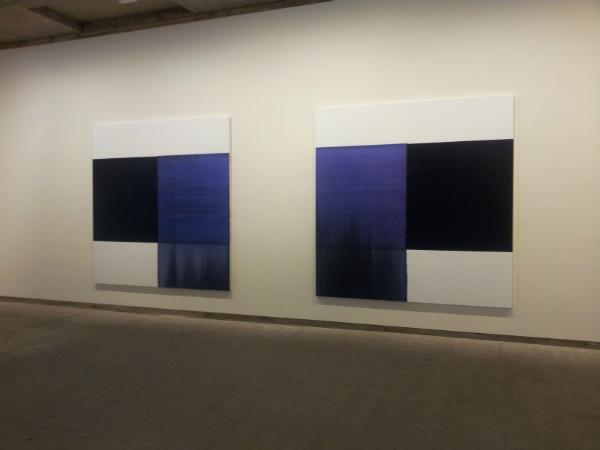The Callum Innes exhibition at Frith Street Gallery repays a little time and attention. On entering the gallery’s darkened premises on Golden Square a small collection of paintings, all at first glance alike, greets you. Walk straight out again and you’d miss the event, for these paintings are exactly that. These are pictures with presence. Their pull is such that simply being in their company is exhilarating, and the whole space is palpably animated by them. The faux industrial interior of the gallery, willfully austere in general, is lent a warm buzz by their addition.
Each work is a unique confection of texture and luminosity. These are qualities that cannot be captured easily on film, indeed my best attempts failed miserably. This contributes to the sense that one’s encounter with them is a reciprocal meeting, a conversation. Not an exhibition to be distractedly consumed via Instagram, a little time and physical proximity is required to get the measure of these quietly powerful works. Their singularity is a result of the process by which they are made; Innes divides the canvases into sections, some of which he paints with multiple layers of paint, building up pigment until he reaches an inky textural block. He then works to remove some of these layers with turpentine, creating a gridded composition in which the final gradation of colour is left, at least partly, to chance. The spectrum covered within this room alone is great, and no two works are the same. Some paintings feature sections which are jewel-like and clear, while others are streaked and mottled. The paint appears on some as a luminous stain, and on others still we see the paint has collected in areas forming dark blots like patches of deep water.
Innes builds on the Modernist abstract tradition, Mondrian’s grid and Rothko and Newman’s charged use of colour are the obvious touchstones. The low-level hum of Rothko and Newman is particularly applicable, and like his forebear’s work, Innes’ paintings seem to vibrate with pent-up energy. Although Mondrian’s carefully delineated grids are referenced, unlike the Dutchman’s impervious containers of pigment, Innes allows the paint seeps satisfyingly over the lines, bleeding into the neighboring brilliant white. This is Modernism for the contemporary world, a Modernism that seeks less to impose order and more to embrace seepage and contamination. This is a more messy, corporeal Modernism, one which echoes and relates to us, that takes us as we are.
What all this leads to is the bodily nature of these paintings: their presence, their latent energy, their porousness. Innes famously works in series, these works being part of the Exposed Paintings series. To me they’re more like a family, interconnected and possessed of shared qualities but each expressing their genetic make-up in divergent ways. The role of chance in determining their final outcome contributes to this sense, the architecture of each is predetermined but the qualities each will possess are unknowable at the start of the process.
Oh yes, and they’re incredibly beautiful. Hovering between taught restraint and sensuous abandon, they are intellectually rigorous and heart flutteringly gorgeous. Don’t miss them.
Callum Innes – Frith Street Gallery – until 24 April 2015
Words: Laura Purseglove photo and Vine video : P A Black © Artlyst 2015 all rights reserved

